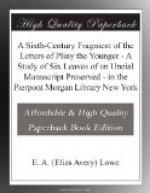Traube, l.c., No. 44: Zangemeister-Wattenbach, pl. XXXV; Steffens{2}, pl. 21b; E.H. Zimmermann, Vorkarolingische Miniaturen (Berlin 1916), pl. 222; but particularly G.B. de Rossi, La biblia offerta da Ceolfrido abbate al sepolcro di S. Pietro, codice antichissimo tra i superstiti delle biblioteche della sede apostolica—Al Sommo Pontefice Leone XIII, omaggio giubilare della biblioteca Vaticana, Rome 1888, No. v.
11. The Treves Prosper (MS. 36, olim S. Matthaei). a. 719
Traube, l.c., No. 306; Zangemeister-Wattenbach,
pl. XLIX;
M. Keuffer, Beschreibendes
Verzeichnis der Handschriften der
Stadtbibliothek zu Trier,
I (1888), pp. 38 sqq.
12. The Milan Manuscript (Ambros. B. 159 sup.) of Gregory’s Moralia, written at Bobbio in the abbacy of Anastasius. ca. a. 750
Traube, l.c., No. 102; Palaeographical Society, pl. 121; E.H. Zimmermann, Vorkarolingische Miniaturen (Berlin 1916), pl. 14-16, Text, pp. 10, 41, 152; A. Reifferscheid, Bibliotheca patrum latinorum italica, II, 38 sq.
13. The Bodleian Acts of the Apostles (MS. Selden supra 30) written in the Isle of Thanet. ante a. 752
Traube, l.c., No. 165; Smith’s
Dictionary of the Bible, IV
(New York 1876) 3458 b; S.
Berger, Histoire de la Vulgate
(Paris 1893), p. 44; Wordsworth
and White, Novum Testamentum,
II (1905), p. vii.
14. The Autun Manuscript (No. 3) of the Gospels, written at Vosevium. a. 754
Traube, l.c., No. 3; Zangemeister-Wattenbach,
pl. LXI;
Steffens{2}, pl. 37.
15. Codex Beneventanus of the Gospels (London Brit. Mus. Add. MS. 5463) written at Benevento. a. 739-760
Traube, l.c., No. 88; Palaeographical
Society, pl. 236;
Catalogue of the Ancient
Manuscripts in the British Museum, II,
pl. 7.
16. The Lucca Manuscript (No. 490) of the Liber Pontificalis. post a. 787
Traube, l.c., No. 92; J.D. Mansi, “De insigni codice Caroli Magni aetate scripto” in Raccolta di opuscoli scientifici e filologici, T. XLV (Venice 1751), ed. A. Calogiera, pp. 78-80; Th. Mommsen, Gesta pontificum romanorum, I (1899) in Monumenta Germaniae Historica; Steffens{2}, pl. 48.
Guided by the above manuscripts, we may proceed to determine the place which the Morgan Pliny occupies in the series of uncial manuscripts. The student of manuscripts recognizes at a glance that the Morgan fragment is, as has been said, distinctly older than the Codex Fuldensis of about the year 546. But how much older? Is it to be compared in antiquity with such venerable monuments as the palimpsest of Cicero’s De Re Publica, with products like the Berlin Computus Paschalis or the Bodleian Chronicle of Eusebius? If we examine carefully the characteristics of our oldest group of fourth- and fifth-century manuscripts and compare them with those of the Morgan manuscript we shall see that the latter, though sharing some of the features found in manuscripts of the oldest group, lacks others and in turn shows features peculiar to manuscripts of a later group.




